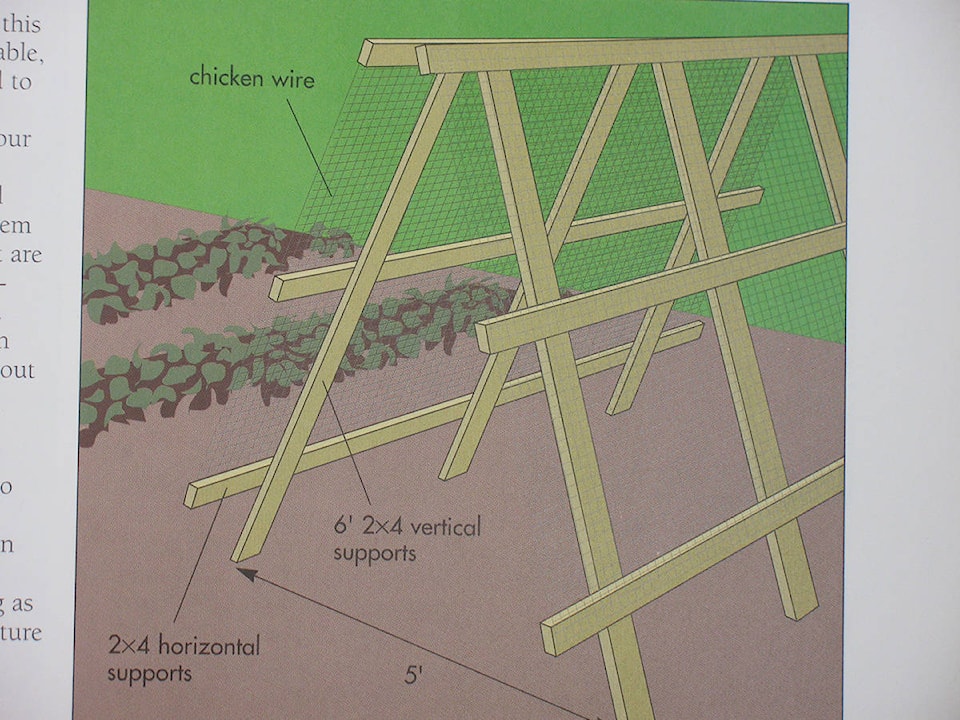By Mary Lowther
Garden books always show tomatoes and peas held up on trellises, but one year I wanted to see what would happen if I let them sprawl on the ground like they’d do naturally. It didn’t occur to me at the time that present day vegetables never existed in the wild and would, in fact, be overrun by stronger wild plants without human intervention. Our vegetables have been developed for flavour, not rigor and must be tended carefully if we are to have a harvest.
Thus, when I let them fall where they may, slugs came out of nowhere and dissolved any tomato or pea touching the ground and trellises became my friends.
Not only does encouraging plants to grow up vertical structures discourage all but the most determined slug from getting to your food before you do, but it keeps the fruit clean and leaves garden space for other crops. Vining plants like tomatoes, peas, beans, squash and cucumber all benefit from being trellised. I tried various methods for trellises and have been using the following ones for a few years.
I use a very simple, easy to erect and dismantle method for peas. I hammer eight-foot lengths of ½ inch rebar into the ground to a depth of two feet. Then I string a length of rope between them at the top after running it through the top side of a piece of nylon mesh designed for this purpose. I tie the sides of the mesh to each pole and batten down the bottom with croquet hooks I stole from David’s set 20 years ago. He hasn’t noticed yet. I read that mesh made of metal like bare chicken wire may burn a plant’s tendrils so we’re better off with nylon, wood or plastic.
I make a similar trellis for beans in a different bed. One year I tried sowing beans in the same bed as the peas once they were almost finished in order to use the same trellis, but they didn’t amount to a hill of beans. I think there might have been too much competition for nutrients in the soil.
I string vining tomatoes up. I nip off the first two side suckers and allow the main stalk plus one or two strong suckers to grow. David and I erect a strong wooden frame with two by fours and I attach lengths of string along the top that dangle down to each stalk and sucker; then I tie the bottom end of each string to the base of each of these and, as they grow, gradually wind each growing tip around its string. This method takes a bit of preparation but it gives the plants room to breathe and enables me to easily see and nip off unwanted suckers. Besides, it’s fun to wind them up the string every few days. A plastic sheet can be thrown over the frame later in the season to keep out the rain so the tomatoes won’t suffer from late blight and to extend the season by keeping the plants warmer at night.
Cucumbers, melons and squash need heavy duty trellises like the A frame in the picture. The two side frames are built separately, then mesh is draped over them and stapled to the frame, acting like a hinge in the middle. If you place the plants on the outsides of the frame, you can plant lettuce and other greens inside where they will benefit from the shade in midsummer. I don’t trellis my squash though because they grow happily among the corn and I think their sharp hairs keep out raccoons. I plant one at each end of the bed and one in the middle and wind them around outside the stalks. Late season winds can blow down a whole crop of corn though, so I also put stakes around the perimeter and tie rope around the corn as it grows.
The time taken to make and install these support structures will pay you back in spades, but there’s one more, perhaps the best, benefit: trellised crops are easier to harvest because you get to stand up to pick them.
Please contact mary_lowther@yahoo.ca with questions and suggestions since I need all the help I can get.
